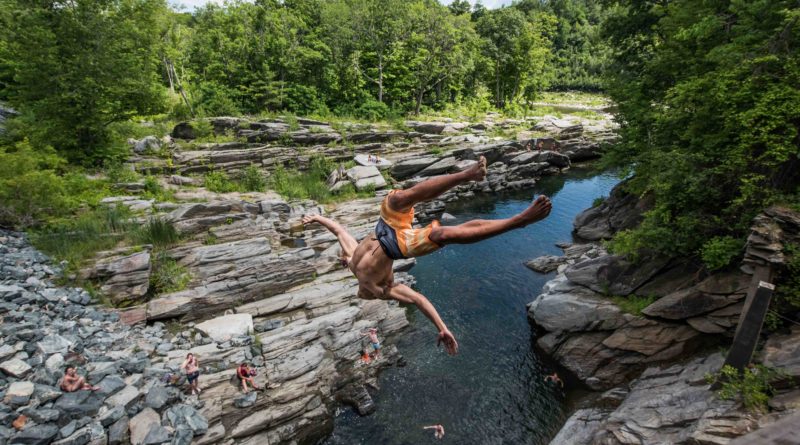Vermont’s Cliff Jumping Revolution
With its endless rivers, quarries and ledges, Vermont has become a hub to the fast-growing action sport of cliff jumping.
By Rylee Ewald
This post was originally published in July of 2018.
One day last spring, Derek McNamara, a 19-year-old from Proctorsville, stood at the edge of a 112-foot cliff, staring down at the glassy water below. The cheers from friends behind him were drowned out by the sound of his own heartbeat thumping in his ears. As he prepared to launch off the cliff, the highest jump he had ever attempted, something didn’t feel right. Normally fearless, Derek felt his breath stick in his chest. His hands were numb. He shook his head and turned from the edge and walked back toward his friends, feeling the cold stone beneath his feet.
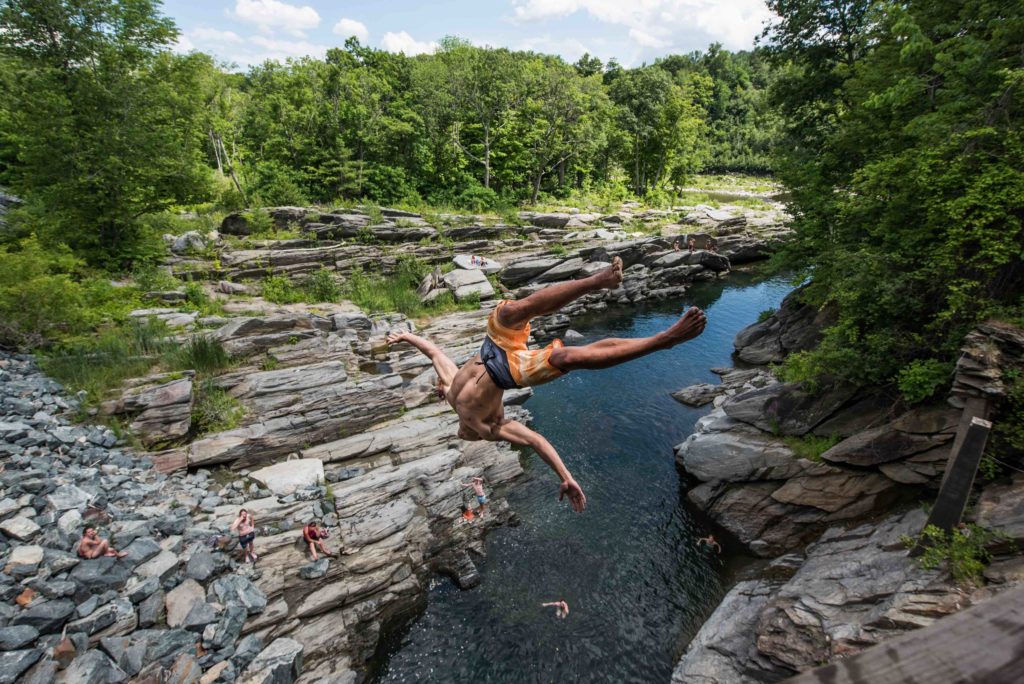
Karen McNamara arrived just in time to see her son turn away from the cliff. As she’d approached the quarry she’d been held up by police, who wanted to know why she was walking on private property.
She asked Derek why he didn’t jump. He said he had already seen multiple people injure themselves that day. Someone had passed out from the impact of hitting the water. Another friend injured his ankle.
“There’s no stopping him. Even if I didn’t like what he was doing, he’d go out and do it anyway,” says Karen, when asked if fear ever gets in the way of supporting Derek and his passion for cliff jumping. “It makes me feel better that [Derek] stops and thinks. He doesn’t go out there just to be crazy. If it’s not feeling right one day, he won’t jump for whatever reason.”
“When you look at a jump and you don’t say to yourself ‘I got this’, if you aren’t 100 percent sure, even 99 percent confident, just don’t do it,” Derek says as he discusses the many times he’s walked away from a jump because he felt “off.”
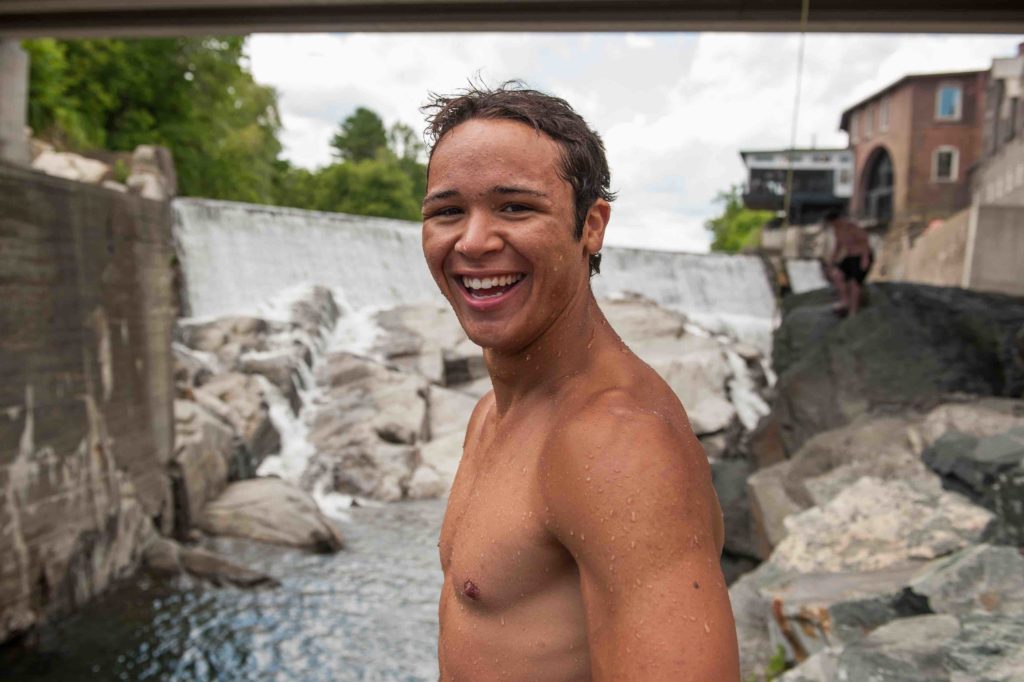
Most cliff jumpers spend numerous hours perfecting their jumps on trampolines and into foam pits before they’re ever ready to follow through with the jump in real life. Confidence is key, Derek stresses when he talks about the quick few moments before he gets ready to jump off an 80-plus-foot cliff.
“It took me a long time to be ready for this jump. I walked away many times… I wasn’t quite ready,” said Derek about the 112-foot cliff.
One day in June he would stand at the top of the cliff, 100 percent confident in himself that he’d land the jump safely. Which he did, completing a perfect flip into the water below where he was greeted by fellow jumpers waiting to high five and fist bump him as he resurfaced.
A Sport on The Rise
Derek grew up near me in Proctorsville, a town with a population of less than 500 people. He spends most of his winters skiing and training and all of his summers cliff jumping. As a kid, I remember him jumping off the top of the trestle bridge, a 38-foot jump which no other kid would ever dare to do.
A freestyle skier at Okemo, Derek’s skiing career was starting to take off when an ACL tear and a bone fracture sidelined him in 2017. That summer he found ways around his injury and continued to cliff dive. After many months at the Dorset Quarry, he started to become recognized for doing big jumps. He started to get invitations to travel around Vermont and beyond with a growing community of cliff divers. Soon, he began meeting cliff divers from across the country.
In the last decade, cliff jumping or diving has become a rising action sport. In 2009, Red Bull introduced a cliff diving competition where elite divers compete from a height of 88 feet—three times the height of a standard Olympic diving platform. Divers are scored on the degree of difficulty, based on factors such as takeoff, number of somersaults, twists, and entry. Even with the rigorous scoring system, the traditional diving format still differs from the array of freestyle tricks that modern jumpers do. Volcom has also begun to dip a toe in the rising sport, by sponsoring young athletes such as Rob Wall and Jay Briggs. The company has even created swim shorts specially designed for cliff jumping.
Videos of people cliff diving have gained popularity online as well. Photographer Brooks Curran’s 2015 montage “A VT Day” showcased some of the state’s top freeskiers spending a day hucking four of Vermont’s popular dive spots in one day: Warren Falls, Bingham Falls, Winooski Quarry and Burlington’s Red Rocks. The video has earned 57,888 views since it was posted on YouTube two years ago. Mike Berritta, creator of Cliff Life Media, has also helped popularize the sport through his videography. His YouTube channels showcase some of Vermont’s top spots and divers. Berritta “discovered” Derek at the Dorset Quarry and introduced him to a network of jumpers from as far away as the West Coast.
“A VT Day” shot by Brooks Curran.
This summer, the first ever full-length cliff diving movie, “Flow State” was released. The film captured jumpers from all around the world, among them athletes in our own state.
Zeke Neubauer, another Dorset Quarry regular, grew up in California jumping cliffs at Lake Havasu, in Arizona. As a kid, Zeke was into BMX mountain biking and practicing tricks on trampolines. He describes the cliff jumping community as “talented kids and athletes who drive each other to do big massive stuff… it’s cool because everyone’s still progressing and has a different style. They work together to push each other. There are really no guidelines,” says Zeke.
“We’re all similarly minded people. We are just a group that likes to go out and have fun,” says Derek.
Every year, what Derek calls a “sendy convention” of jumpers from the East Coast and West Coast meet up in a new location for the event officially named East x West, which made its debut in 2012. Anyone who is welcome. The 2017 East x West was held in Barre.
Footage of 2017’s East x West by Nick Coulter.
As we talk, Derek pull up plane tickets to a competition at the end of July called the Colorado Cliff Cruise. Billed as a gathering of “60 of the best cliff jumpers and divers,” the competition (held in California this year) features a 40-foot jump and a 70-foot jump. Derek was thrilled to be invited. “I’m very excited, but terrified at the same time,” he admitted.
As he jumped more and more, Derek has become familiar with cliff jumpers from Vermont. But as he watched videos of the sport online, he was surprised to discover how many people across the country were as dedicated to jumping as he was. He began connecting with others on Instagram after watching their videos. Soon his own Instagram feed became dedicated to clips of him jumping.
“I wasn’t quite in the group yet. I knew I wanted to hang out with these people more, so I had to do something crazy,” says Derek. At some point, a light bulb went off in his head: “I decided I had to light myself on fire,” he said. To prove himself to his fellow jumpers, Derek (who volunteers as a firefighter in Proctorsville) wore a wetsuit covered in Vaseline. He had someone ignite the suit as he jumped off an 88-foot cliff into the ocean in Acadia National Park, Maine.
Like many skiers, Derek grew up training with trampolines, foam pits, and the occasional cliff jump. In the winter though, he spent most of his time at Okemo’s terrain parks. His ACL tear sent him into several months of recovery. “I’m the kind of person who can’t sit still. The first couple of days I was like ‘Wow, this is great, people are waiting on me.’ Then a week passed and I was going crazy,” Derek says. When he came back from his long, drawn-out period of recovery, it was summer. He missed the thrill of flipping through the air on skis, so he decided to get
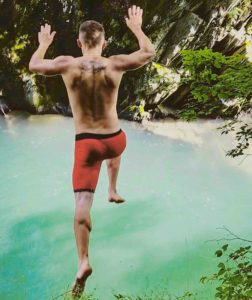
serious about cliff jumping. “I was basically jumping with an immobile leg. I would wrap and compress my healing knee with anything I could before I jumped.” Derek was so eager to get back in the air that any fears he had about reinjuring his knee were thrown aside.
Derek acknowledges the similarity between freestyle skiing and cliff jumping. Most serious cliff jumpers got their start in another sport, whether that be skiing, gymnastics, or diving. He says that like skiing, cliff diving takes a lot of training and practice at something he calls “aerial awareness.” He also says that the sport requires that participants stay active to avoid injury. “Since cliff jumping is such a new sport, we’re all still learning… We take tricks from sports like skiing and we add something new to them, and we rename them… The people who thrive the most in this sport are the people who come from some kind of other sport background…”
University of Vermont freeskiing coach Noah Labow says that the “cliff jumping game” involves maneuvers that are very similar to freestyle skiing tricks. The sports involve similar training and Noah stresses the importance of aerial awareness as well as takeoff in both arenas. “If you are already off-balance or unaligned on your take-off, this can make for a sloppy jump.” He likes to think about jumping in three parts, take off, airtime balance and your landing position. Jumpers should always land feet first. Often, beginners forget to untuck their knees and leave their arms out to the side, a mistake that can lead to injury when jumping from high heights. A “pencil jump” can also lead to a loss of balance, resulting in landing on ones back. Aerial awareness is an important component of a jump, since most jumpers spend airtime falling. “Practicing aerial awareness is meant to help you in an uncomfortable setting,” Labow says.
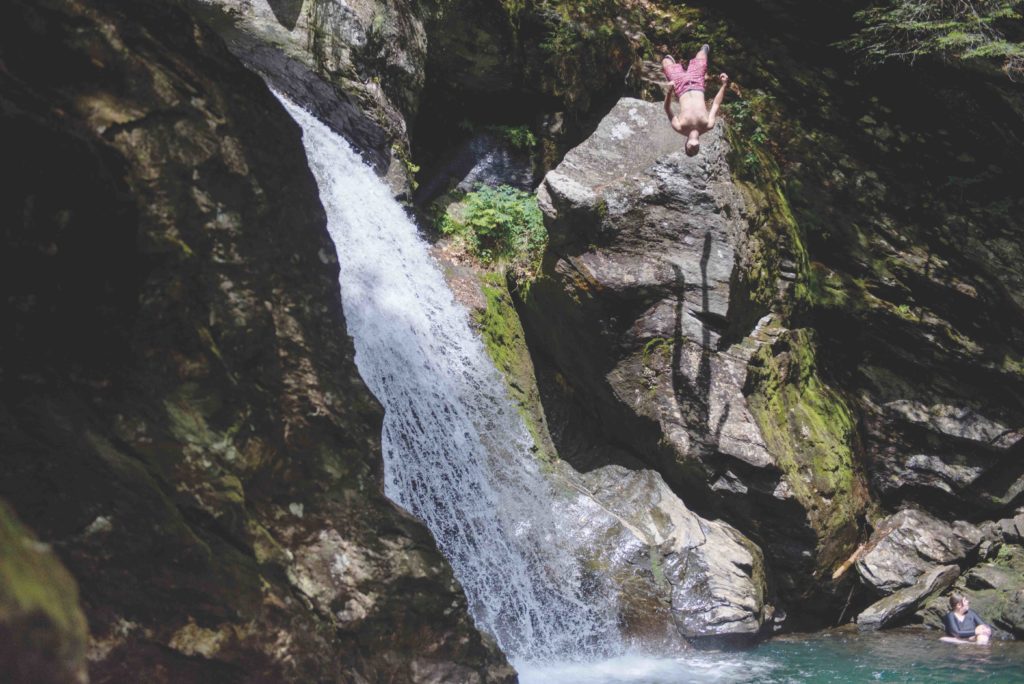
I watched Derek try to perfect a gainer cork 720, which is a move specific to the sport of cliff jumping. He said he had watched a video of the trick from another jumper and practiced it at a much smaller, safer height before he tried it for the first time off the Quechee covered bridge as I watched. Flopping the jump the first time from the smaller height, Derek knew that he wasn’t ready to take on the gainer cork 720 from the very top of the bridge. The historic structure rests 50 feet above the water below, making it a jump with consequences for failure.
Jumps With Consequences
With the steady rise of cliff jumping and its growing presence in social media, people are increasingly copying tricks they see from videos posted online. Jumpers who know what they are doing won’t attempt a jump until they’re confident they will be able to safely perform it. That’s not always the case with those less experienced.
In 2015, at Red Rocks in Burlington, Michael Hansen, 41, of Shelburne jumped from a 70-foot cliff and died on impact. In July 2017, William Caulkins of Cohoes, NY, jumped from a 100-foot-high ledge in the Barre granite quarries — a place where swimming and diving are prohibited — and had to be airlifted to the intensive care unit at Dartmouth Hitchcock hospital. In early July of this year, Ryan Syszmanski, 22, an experienced cliff diver, former gymnast and free runner, was filmed jumping off a similarly high ledge in Barre. He tore every ligament in his knee. The video of his jump went viral and was picked up by news outlets such as Inside Edition. “Even though I’m watching from the outside now, I’m absolutely thrilled that this sport is continuing to grow like it is— with people like @clifflifemedia and @jakeofalltrades808 leading the charge,” Syszmanski posted on Instagram.
All summer around Vermont, you can see people jumping off cliffs into swimming holes. Popular spots include Dorset Quarry, Quechee Gorge, Red Rocks, Bingham Falls and various quarries.
Stowe Mountain Rescue’s Doug Veliko says that in the summer about 20 percent of calls to the rescue team are swimming hole-related, whether that be Bingham Falls, Glen Moss Falls, or other places near Stowe. They aren’t all necessarily jumping-related, but often steep cliffs lead to slips that end in injury. Veliko says most of the calls he gets are from 19- to 22-year-old males, many of whom are under the influence of drugs or alcohol. He believes that people take little to no precautions when preparing for a jump. “People get misled. They think ‘Oh I’ve been swimming here for 20 years,’ but things change,” Veliko said.
Veliko suggests that people scout out pools, launch sites, and look for wet rocks before attempting a jump, even in a place they are familiar with. He also advises that no one consume alcohol or drugs. This year, with the lack of rain, water levels are low. As a benchmark, Lake Champlain’s water level was at 98 feet at the King Street Ferry Dock in Burlington in May. As of late July, it had dropped four feet.
Another problem with cliff jumping is that access to many swimming holes requires crossing private land. Most often, encounters between jumpers and police are due to trespassing complaints. Owners of the property can be held liable for injuries, or even worse, fatalities that happen on their land.
Chief William Dodge of the Barre Town Police Department says that during the summer of 2017 there were only an estimated three or four calls specifically involving cliff jumping incidents— although there are many other complaints at the quarries involving trespassing. “I don’t know of any regulations specifically regarding cliff jumping, but in our case the entire property is posted, therefore people who cliff dive are trespassing,” says Chief Dodge.
Derek says that as long as you respect the police, leave when you are asked, and stay honest with them, little trouble comes out of these encounters. Serious jumpers cooperate with authorities and leave no trace, often due to fear that their favorite jumping spots will be shut down.
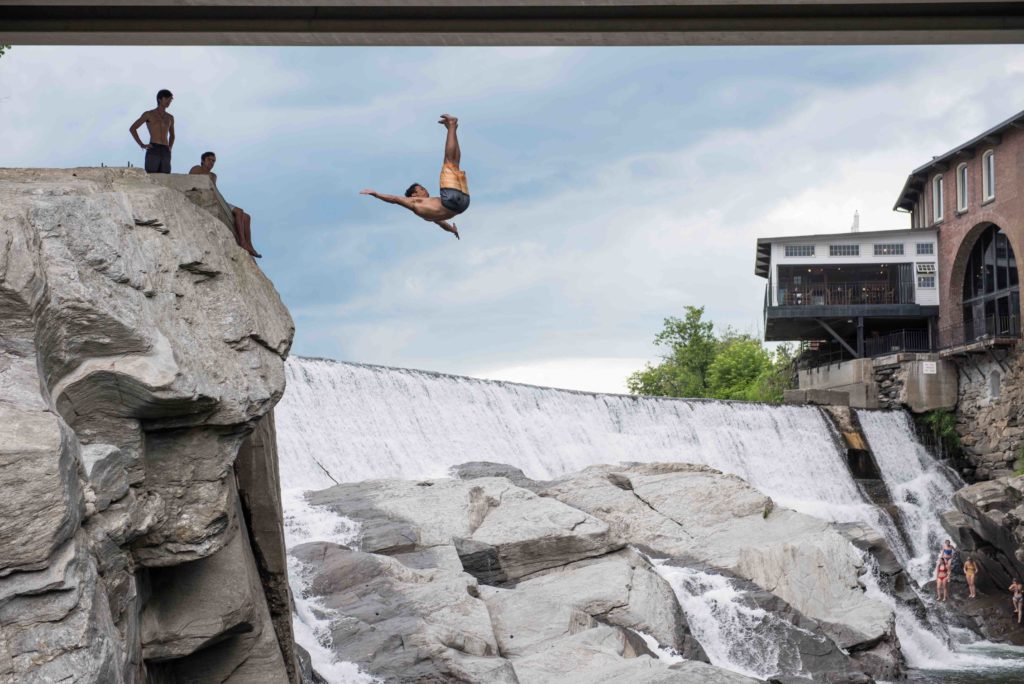
Another rule of thumb Derek adheres to is to make sure there are people in the water when a person is jumping. “One, it’s fun to fist-bump someone after you stomp a jump, but also we take into consideration that things go wrong… humans are humans,” he says. He also takes time to swim at depth to make sure a pool is deep enough for the jump he plans to attempt. Serious cliff jumpers always check launch sites for slippery rocks, landing pools for debris and depth, and never try a jump they aren’t ready or practiced for.
Derek sees cliff jumping as a serious sport and says he could see himself coaching younger children in it someday. He acknowledges the big steps that Red Bull and Volcom have already taken to reinvent the sport. Because of cliff jumping, Derek has his own bucket list of spots he hopes jumping will take him, among them; New Zealand, Australia, and Thailand.
Noah Labow, who now coaches freestyle skiing at Green Mountain Academy, says that cliff jumping, as well as many other freestyle sports, have made their name only recently. “I slowly worked my way up,” he says of the jumps he did as a freestyle skier in his early 20s. “The modern era of cliff jumping is pretty extreme… I consider a fall fatal at 55 feet. These guys are jumping off of 80+ foot cliffs.” Noah also has a 50- to -60-foot rule. He won’t jump anything over that height, because of the massive amount of impact.
After interviewing Derek, I tagged along to watch him jump from the Quechee covered bridge into the Ottauquechee River. Derek was prepared to jump from over 50 feet, off of the covered bridge above me.
As I sat there waiting for him to jump, I was more nervous than he was. Before he jumped, he rolled his shoulders, took a deep breath and dove from the bridge, doing a single flip. He fell in slow motion and straightened out before piercing the surface of the water far below. I didn’t let myself relax until I saw his head break the surface.
As Derek gracefully dived and flipped with ease, capturing the attention of many, I hesitantly climbed a 25-foot cliff. Then, with a series of shrieks (confirming that I was definitely not meant for the sport), I jumped. Cliff jumping, I decided, takes so much more than the courage to huck yourself off a ledge.
Diving In
You can find swimming holes all over Vermont but a few places, such as Dorset Quarry, Bingham Falls, Warren Falls and Red Rocks are known for cliff diving. Always check the depth of the entire pool, especially as water is very low this year, due to droughts. Don’t trespass, know the conditions, your skills and be prepared.
Aerial Awareness: Mastering midair control. Aerial Awareness is practiced on trampolines and into foam pits to help master a trick.
A Double: Two flips.
Gainer Cork 720: A moving forward back flip where you are running at the cliff, with a twisting fall backwards.
Double Back: A double backflip.
Triple Half: A flip with a half twist (180 degrees) done three times.
Front 540 (Misty): Spinning forward into a rotation leaning forward.
Gainer: A backwards somersault while still moving forward.
Double 10: Three rotations on axis combined with two flips off axis.
Cork (Cab) 7: Two full rotations (360 degrees twice) of an off axis or inverted horizontal rotation.
Dub Lay: Straight body, layed out backflip.
Back Full: A backflip with a 360.
Double Gainer: A backwards somersault where the person flips twice, instead of just once.
Follow McNamara’s most recent adventures on his Instagram page @sendsquatch

